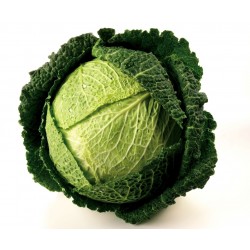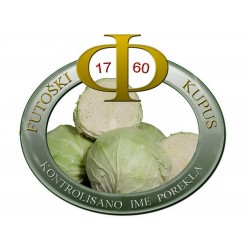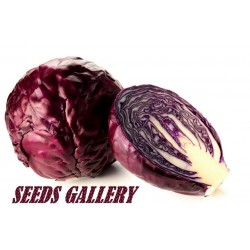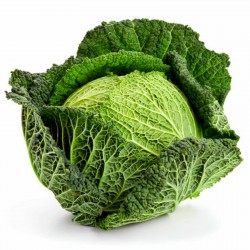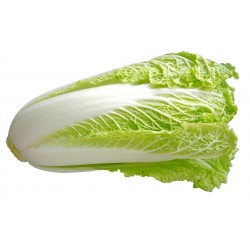Seeds Gallery Com,
5/
5
<h2><span style="text-decoration: underline;"><strong><em>Broccoli Ramoso Calabrese Seeds</em></strong></span></h2>
<h3><span style="color: #f40202;"><strong>Price for Package of 50 seeds.</strong></span></h3>
<p><span>Old reliable heirloom variety, light green plants, 10 cm green central head, lots of medium sized side shoots, non-uniform in maturity, more productive than many hybrids, excellent quality and flavour.</span></p>
<p><span>Sowing instructions: Plant seeds 0.5 inches deep indoors from March-April or directly outdoors from May-June. Transplant seedlings from May-July spacing them 18 inches apart in rows spaced 36 inches apart. Harvest from July-September.</span></p>
<p><span>Maturity: 60-70 days Open-pollinated Heirloom</span></p>
<h2><strong><a href="https://en.wikipedia.org/wiki/Broccoli" target="_blank" rel="noreferrer noopener">WIKIPEDIA:</a><br /></strong></h2>
<p><b>Broccoli</b> is an edible green plant in the cabbage family whose large flowering head is eaten as a vegetable.</p>
<p>The word <i>broccoli</i> comes from the Italian plural of <i><span lang="it" xml:lang="it">broccolo</span></i>, which means "the flowering crest of a cabbage", and is the diminutive form of <i>brocco</i>, meaning "small nail" or "sprout".<sup id="cite_ref-3" class="reference">[3]</sup> Broccoli is often boiled or steamed but may be eaten raw.<sup id="cite_ref-4" class="reference">[4]</sup></p>
<p>Broccoli is classified in the Italica cultivar group of the species <i>Brassica oleracea</i>. Broccoli has large flower heads, usually green in color, arranged in a tree-like structure branching out from a thick, edible stalk. The mass of flower heads is surrounded by leaves. Broccoli resembles cauliflower, which is a different cultivar group of the same species.</p>
<p>Broccoli is a result of careful breeding of cultivated <i>Brassica</i> crops in the northern Mediterranean starting in about the 6th century BC.<sup id="cite_ref-VB_5-0" class="reference">[5]</sup> Since the time of the Roman Empire, broccoli has been considered a uniquely valuable food among Italians.<sup id="cite_ref-NI_6-0" class="reference">[6]</sup> Broccoli was brought to England from Antwerp in the mid-18th century by Peter Scheemakers.<sup id="cite_ref-7" class="reference">[7]</sup>Broccoli was first introduced to the United States by Southern Italian immigrants, but did not become widely popular until the 1920s.</p>
<h2><span class="mw-headline" id="Varieties">Varieties</span></h2>
<div class="thumb tright">
<div class="thumbinner"><img alt="" src="https://upload.wikimedia.org/wikipedia/commons/thumb/3/34/Broccoli_plants_growing_in_New_Jersey_in_April.jpg/220px-Broccoli_plants_growing_in_New_Jersey_in_April.jpg" width="220" height="161" class="thumbimage" />
<div class="thumbcaption">
<div class="magnify"></div>
Broccoli plants in a nursery</div>
</div>
</div>
<p>There are three commonly grown types of broccoli. The most familiar is <b>Calabrese broccoli</b>, often referred to simply as "broccoli", named after Calabria in Italy. It has large (10 to 20 cm) green heads and thick stalks. It is a cool season annual crop. <b>Sprouting broccoli</b> has a larger number of heads with many thin stalks. <b>Purple cauliflower</b> is a type of broccoli grown in Europe and North America. It has a head shaped like cauliflower, but consisting of tiny flower buds. It sometimes, but not always, has a purple cast to the tips of the flower buds.</p>
<p>Other cultivar groups of <i>Brassica oleracea</i> include cabbage (Capitata Group), cauliflower and Romanesco broccoli (Botrytis Group), kale and collard greens (Acephala Group), kohlrabi (Gongylodes Group), Brussels sprouts (Gemmifera Group), and kai-lan (Alboglabra Group).<sup id="cite_ref-Dixon2007_9-0" class="reference">[9]</sup> Rapini, sometimes called "broccoli raab" among other names, forms similar but smaller heads, and is actually a type of turnip (<i>Brassica rapa</i>). Broccolini or "Tenderstem broccoli" is a cross between broccoli and Chinese broccoli. Beneforté is a variety of broccoli containing 2–3 times more glucoraphanin that was produced by crossing broccoli with a wild Brassica variety, <i>Brassica oleracea</i> var <i>villosa</i>.<sup id="cite_ref-10" class="reference">[10]</sup></p>
<h2><span class="mw-headline" id="Production">Production</span></h2>
<table class="wikitable">
<tbody>
<tr>
<th colspan="2">Broccoli production—2014<br /><small>includes cauliflower,<sup id="cite_ref-fao14_11-0" class="reference">[11]</sup> millions of tonnes</small></th>
</tr>
<tr>
<th>Country</th>
<th>Production</th>
</tr>
<tr>
<td align="left"><span class="flagicon"><img alt="" src="https://upload.wikimedia.org/wikipedia/commons/thumb/f/fa/Flag_of_the_People%27s_Republic_of_China.svg/23px-Flag_of_the_People%27s_Republic_of_China.svg.png" width="23" height="15" class="thumbborder" /> </span>People's Republic of China</td>
<td><center>9.3</center></td>
</tr>
<tr>
<td align="left"><span class="flagicon"><img alt="" src="https://upload.wikimedia.org/wikipedia/en/thumb/4/41/Flag_of_India.svg/23px-Flag_of_India.svg.png" width="23" height="15" class="thumbborder" /> </span>India</td>
<td><center>8.6</center></td>
</tr>
<tr>
<td align="left"><span class="flagicon"><img alt="" src="https://upload.wikimedia.org/wikipedia/en/thumb/a/a4/Flag_of_the_United_States.svg/23px-Flag_of_the_United_States.svg.png" width="23" height="12" class="thumbborder" /> </span>United States</td>
<td><center>1.2</center></td>
</tr>
<tr>
<td align="left"><span class="flagicon"><img alt="" src="https://upload.wikimedia.org/wikipedia/en/thumb/9/9a/Flag_of_Spain.svg/23px-Flag_of_Spain.svg.png" width="23" height="15" class="thumbborder" /> </span>Spain</td>
<td><center>0.6</center></td>
</tr>
<tr>
<td align="left"><span class="flagicon"><img alt="" src="https://upload.wikimedia.org/wikipedia/commons/thumb/f/fc/Flag_of_Mexico.svg/23px-Flag_of_Mexico.svg.png" width="23" height="13" class="thumbborder" /> </span>Mexico</td>
<td><center>0.5</center></td>
</tr>
<tr>
<td align="left"><span class="flagicon"><img alt="" src="https://upload.wikimedia.org/wikipedia/en/thumb/0/03/Flag_of_Italy.svg/23px-Flag_of_Italy.svg.png" width="23" height="15" class="thumbborder" /> </span>Italy</td>
<td><center>0.4</center></td>
</tr>
<tr>
<td align="left"><b>World</b></td>
<td><center><b>24.2</b></center></td>
</tr>
</tbody>
</table>
<p>In 2014, global production of broccoli (combined for production reports with cauliflowers) was 24.2 million tonnes, with China and India together accounting for 74% of the total (table).<sup id="cite_ref-fao14_11-1" class="reference">[11]</sup> Secondary producers, each having one million tonnes or less annually, were the United States, Spain, Mexico and Italy (table).<sup id="cite_ref-fao14_11-2" class="reference">[11]</sup> The US Department of Agriculture reported that national production just of broccoli in 2014 was 0.95 million tonnes, nearly all of which was grown in California.<sup id="cite_ref-12" class="reference">[12]</sup></p>
<h3><span class="mw-headline" id="Cultivation">Cultivation</span></h3>
<p>Broccoli is a cool-weather crop that does poorly in hot summer weather. Broccoli grows best when exposed to an average daily temperature between 18 and 23 °C (64 and 73 °F).<sup id="cite_ref-13" class="reference">[13]</sup> When the cluster of flowers, also referred to as a "head" of broccoli, appear in the center of the plant, the cluster is green. Garden pruners or shears are used to cut the head about an inch from the tip. Broccoli should be harvested before the flowers on the head bloom bright yellow.<sup id="cite_ref-14" class="reference">[14]</sup></p>
<p>While the heading broccoli variety performs poorly in hot weather, mainly due to insect infestation, the sprouting variety is more resistant, though attention must be paid to sucking insects (such as aphids), caterpillars and whiteflies. Spraying of <i>bacillus thuringiensis</i> can control caterpillar attacks, while a citronella vase may ward off whiteflies.<sup id="cite_ref-15" class="reference">[15]</sup></p>
<h3><span class="mw-headline" id="Pests">Pests</span></h3>
<p>Mostly introduced by accident to North America, Australia and New Zealand, "cabbage worms", the larvae of <i>Pieris rapae</i>, the small white butterfly are a common pest in broccoli.<sup id="cite_ref-16" class="reference">[16]</sup></p>
<h2><span class="mw-headline" id="Nutrition">Nutrition</span></h2>
<table class="infobox nowrap"><caption>Broccoli, raw (edible parts)</caption>
<tbody>
<tr>
<th colspan="2">Nutritional value per 100 g (3.5 oz)</th>
</tr>
<tr>
<th scope="row">Energy</th>
<td>141 kJ (34 kcal)</td>
</tr>
<tr>
<td colspan="2"></td>
</tr>
<tr>
<th scope="row">
<div><b>Carbohydrates</b></div>
</th>
<td>
<div>6.64 g</div>
</td>
</tr>
<tr>
<th scope="row">Sugars</th>
<td>1.7 g</td>
</tr>
<tr>
<th scope="row">Dietary fiber</th>
<td>2.6 g</td>
</tr>
<tr>
<td colspan="2"></td>
</tr>
<tr>
<th scope="row">
<div><b>Fat</b></div>
</th>
<td>
<div>0.37 g</div>
</td>
</tr>
<tr>
<td colspan="2"></td>
</tr>
<tr>
<th scope="row">
<div><b>Protein</b></div>
</th>
<td>
<div>2.82 g</div>
</td>
</tr>
<tr>
<td colspan="2"></td>
</tr>
<tr>
<th colspan="2">Vitamins</th>
</tr>
<tr>
<th scope="row">Vitamin A equiv.
<div>beta-Carotene</div>
<div>lutein zeaxanthin</div>
</th>
<td>
<div>(4%)</div>
31 μg
<div>
<div>(3%)</div>
361 μg</div>
<div>1403 μg</div>
</td>
</tr>
<tr>
<th scope="row">Thiamine <span>(B<span><span>1</span></span>)</span></th>
<td>
<div>(6%)</div>
0.071 mg</td>
</tr>
<tr>
<th scope="row">Riboflavin <span>(B<span><span>2</span></span>)</span></th>
<td>
<div>(10%)</div>
0.117 mg</td>
</tr>
<tr>
<th scope="row">Niacin <span>(B<span><span>3</span></span>)</span></th>
<td>
<div>(4%)</div>
0.639 mg</td>
</tr>
<tr>
<th scope="row">Pantothenic acid <span>(B<span><span>5</span></span>)</span></th>
<td>
<div>(11%)</div>
0.573 mg</td>
</tr>
<tr>
<th scope="row">Vitamin B<span><span>6</span></span></th>
<td>
<div>(13%)</div>
0.175 mg</td>
</tr>
<tr>
<th scope="row">Folate <span>(B<span><span>9</span></span>)</span></th>
<td>
<div>(16%)</div>
63 μg</td>
</tr>
<tr>
<th scope="row">Vitamin C</th>
<td>
<div>(107%)</div>
89.2 mg</td>
</tr>
<tr>
<th scope="row">Vitamin E</th>
<td>
<div>(5%)</div>
0.78 mg</td>
</tr>
<tr>
<th scope="row">Vitamin K</th>
<td>
<div>(97%)</div>
101.6 μg</td>
</tr>
<tr>
<td colspan="2"></td>
</tr>
<tr>
<th colspan="2">Minerals</th>
</tr>
<tr>
<th scope="row">Calcium</th>
<td>
<div>(5%)</div>
47 mg</td>
</tr>
<tr>
<th scope="row">Iron</th>
<td>
<div>(6%)</div>
0.73 mg</td>
</tr>
<tr>
<th scope="row">Magnesium</th>
<td>
<div>(6%)</div>
21 mg</td>
</tr>
<tr>
<th scope="row">Manganese</th>
<td>
<div>(10%)</div>
0.21 mg</td>
</tr>
<tr>
<th scope="row">Phosphorus</th>
<td>
<div>(9%)</div>
66 mg</td>
</tr>
<tr>
<th scope="row">Potassium</th>
<td>
<div>(7%)</div>
316 mg</td>
</tr>
<tr>
<th scope="row">Sodium</th>
<td>
<div>(2%)</div>
33 mg</td>
</tr>
<tr>
<th scope="row">Zinc</th>
<td>
<div>(4%)</div>
0.41 mg</td>
</tr>
<tr>
<td colspan="2"></td>
</tr>
<tr>
<th colspan="2">Other constituents</th>
</tr>
<tr>
<th scope="row">Water</th>
<td>89.3 g</td>
</tr>
<tr>
<td colspan="2"><hr />
<div class="wrap">Link to USDA Database entry</div>
</td>
</tr>
<tr>
<td colspan="2">
<div class="plainlist">
<ul>
<li>Units</li>
<li>μg = micrograms • mg = milligrams</li>
<li>IU = International units</li>
</ul>
</div>
</td>
</tr>
<tr>
<td colspan="2" class="wrap">Percentages are roughly approximated using US recommendations for adults.<br /><span class="nowrap"><span>Source: USDA Nutrient Database</span></span></td>
</tr>
</tbody>
</table>
<p>As shown on the table, a 100 gram serving of raw broccoli provides 34 kcal and is an excellent source (20% or higher of the Daily Value, DV) of vitamin C and vitamin K. Raw broccoli also contains moderate amounts (10–19% DV) of several B vitamins and the dietary mineral manganese, whereas other essential nutrients are in low content. Broccoli has low content of carbohydrates, protein, fat, and dietary fiber.</p>
<p>Boiling broccoli reduces the levels of sulforaphane, with losses of 20–30% after five minutes, 40–50% after ten minutes, and 77% after thirty minutes.<sup id="cite_ref-boil_17-0" class="reference">[17]</sup><sup id="cite_ref-ReferenceA_18-0" class="reference">[18]</sup> However, other preparation methods such as steaming,<sup id="cite_ref-ReferenceA_18-1" class="reference">[18]</sup><sup id="cite_ref-maximize_19-0" class="reference">[19]</sup> microwaving, and stir frying had no significant effect on the compounds.<sup id="cite_ref-boil_17-1" class="reference">[17]</sup></p>
<p>Broccoli also contains the carotenoid compounds lutein and zeaxanthin in amounts about 6 times lower than in kale.</p>
<h2><span class="mw-headline" id="Taste">Taste</span></h2>
<p>The perceived bitterness of cruciferous vegetables such as broccoli varies from person to person, but the functional underpinnings of this variation are not known. Some research reports that the gene TAS2R38 may be responsible for bitter taste perception in broccoli.<sup id="cite_ref-20" class="reference">[20]</sup> Other factors, such as isothiocyanates and polyphenols, are also likely involved in bitterness perception.<sup id="cite_ref-21" class="reference">[21]</sup></p>
<h2><span class="mw-headline" id="Gallery">Gallery</span></h2>
<table>
<tbody>
<tr>
<td>
<table>
<tbody>
<tr>
<td>
<div class="center">
<div class="floatnone"><a href="https://en.wikipedia.org/wiki/File:Sa_broccoli_florets.jpg" class="image" title="Close-ups of broccoli florets"><img alt="" src="https://upload.wikimedia.org/wikipedia/commons/thumb/1/1c/Sa_broccoli_florets.jpg/500px-Sa_broccoli_florets.jpg" width="500" height="109" class="thumbborder" /></a></div>
</div>
</td>
</tr>
<tr>
<td>
<div class="gallerytext">Close-ups of broccoli florets </div>
</td>
</tr>
</tbody>
</table>
<table>
<tbody>
<tr>
<td>
<div class="center">
<div class="floatnone"><a href="https://en.wikipedia.org/wiki/File:Cavolfiore_Violetto_di_Sicilia.jpg" class="image" title="Sicilian purple broccoli"><img alt="" src="https://upload.wikimedia.org/wikipedia/commons/thumb/8/85/Cavolfiore_Violetto_di_Sicilia.jpg/180px-Cavolfiore_Violetto_di_Sicilia.jpg" width="180" height="159" class="thumbborder" /></a></div>
</div>
</td>
</tr>
<tr>
<td>
<div class="gallerytext">Sicilian purple broccoli </div>
</td>
</tr>
</tbody>
</table>
<table>
<tbody>
<tr>
<td>
<div class="center">
<div class="floatnone"><a href="https://en.wikipedia.org/wiki/File:Fractal_Broccoli.jpg" class="image" title="Romanesco broccoli (actually a cauliflower cultivar), showing fractal forms"><img alt="" src="https://upload.wikimedia.org/wikipedia/commons/thumb/4/4f/Fractal_Broccoli.jpg/180px-Fractal_Broccoli.jpg" width="180" height="135" class="thumbborder" /></a></div>
</div>
</td>
</tr>
<tr>
<td>
<div class="gallerytext"><a href="https://en.wikipedia.org/wiki/Romanesco_broccoli" title="Romanesco broccoli">Romanesco broccoli</a> (actually a cauliflower cultivar), showing <a href="https://en.wikipedia.org/wiki/Fractal" title="Fractal">fractal</a> forms </div>
</td>
</tr>
</tbody>
</table>
</td>
</tr>
</tbody>
</table>
VE 179 (50 S)










